A key part of the role of a product marketer is engaging the sales teams and getting them to take our messages to drive go-to-market strategy - and that can be difficult. It sounds a lot easier on paper, but there's a lot of challenges that get in the way. So what are they? And what are some practical things we can do to get through them?
Now, a lot of people have taken pragmatic training, so they know all the best practices, but I'm going to give more detailed examples for use in practical application, things that you can try with your go-to-market strategy, and ways to engage your sales force to capture that market opportunity.
Starting off with a little bit of a story. Back in 2016, at Akamai (a content delivery network that makes the internet fast, reliable and secure - acceleration, security, media streaming are all core to the business), we had decided, based on feedback from customers, that there was a huge opportunity to optimise images. The front end of the website was very slow, with big, heavy, overweight images, and so the product development team had developed this service that would allow us to transform and optimise these images. The challenge was that our sales teams didn't really know much about images or the front end of the website - they're used to talking about network acceleration and security, so it would be difficult for them to speak knowledgeably to the stakeholders and to the buyers on how we can optimise and impact the images. We're talking about JPEGs and JPEG 2000 - they didn't even know what the image formats were, let alone how to talk about how we're going to optimize them and make the website the highest quality possible for the least amount of bytes. So that was where our big enablement challenge came.
We had to build the whole launch plan and come up with a strategy for how we were going to find our piece of that market. But then also at the same time, how we were going to leverage our sales teams to be able to knowledgeably take these messages to market and sell this product to our customers and to prospects.
I think oftentimes as product marketers, we lack a little bit of empathy for our sales teams. In reality, there's a lot of challenges to being a salesperson - I spent a lot of time with the sales people trying to understand them. Put yourself in a salesperson’s shoes for a minute. At Akamai, as an example, there's dozens of products to sell and understand. So that's a challenge right there - information overload. And there's a lot of distractions because they have to own and drive their core business market.
Context can be difficult - when a salesperson has a number, they're focused on hitting that number, but as product marketers, we're trying to get them to look at analyst reports, understand the market, and do broad competitive analysis. Sometimes they're just too narrowly focused. The messages can become fragmented when we're trying to put the onus on them to put the pieces together, and if we don't connect the threads for them, they're grasping at different things without really knowing how to put them together.
Lack of trust in the message can also cause problems. We need to establish credibility with the sales teams - for them to trust that what we're asking them to do is going to drive success for them, and that is very important because if you burn your sales team the first time with incorrect information or something that doesn't work, you lose the right to go back to them again with that guidance.
And then the game of Chinese whispers. You know, tell one person, the next person, the next person, the message gets completely diluted. By the time you hear it at the end it’s completely wrong. So how can you make sure you're driving consistency in the message?
Strategy #1: get in the jump seat

Nothing interesting happens in the office - it’s incredibly important to get out in the field with the sales teams and here's a methodology that I've used with great success. We call it ‘pressure cooker training’. Essentially, you do a half day with the sales and pre-sales teams as solutions engineers - they're called different things at different companies. In that half day, make sure that whatever concentrated training you're trying to do, it's structured, make sure it's interactive. And then on the back end of that, have one to two days of meetings booked with customers. This way, you're going to train the sales team, meet with customers and see the impact of that training, real time. Then do a half day debrief back in the office afterwards - get some feedback and give some feedback. It is an incredibly valuable way to get your feet on the ground.
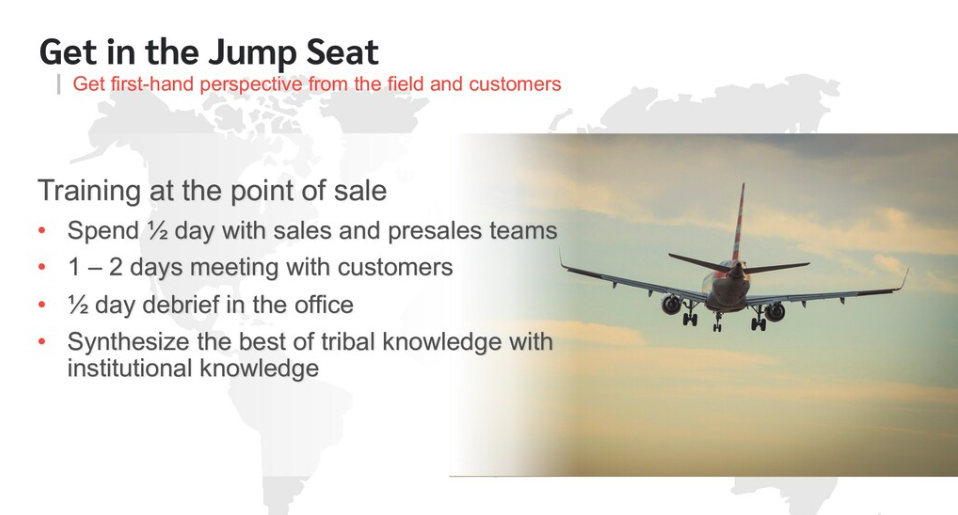
This is extremely important when you're talking about expanding into a geographically dispersed region, like Asia, for example. I did this in Japan, where sometimes webinar training over the phone just doesn't really work as well - there's not a lot of questions coming in over the line and it's really hard to make that interactive. You need to get out into the field to understand the dynamic of the interaction between the salespeople and the customers. This way, you'll learn a lot more about what they're really challenged by and you'll have the opportunity to affect that in a very engaging and interactive way.
Critical to this is to also take the best of the tribal knowledge - see which salespeople are doing a really great job, and integrate that back into the institutional knowledge. As product marketers, we're very creative - we like our pitch decks, we like the slides we create, but sometimes things come out of the field that are gold, and it's in our best interest to integrate them into the core assets and message, and then drive that back out with consistency to the rest of the field. That way, you have the best of the best, not just what was ideated in the ivory tower of HQ.
So, what are some of the advantages to doing this?
- You get to validate your messaging with customers and get feedback without the filter of salespeople. Salespeople listen differently than we do. They listen to sell. We're listening to improve our messaging or to align our capabilities to market challenges. And so oftentimes, when we ask the sales teams for feedback, we're going to get a different story than if we were there ourselves.
- Another thing that's really beneficial is to build a tribe process and a value confirmation model. This is a bit of ‘give to get’ and can also empower the sales teams and take some of the onus off of them. You can empower sales to deliver the message and the tools exactly as you would, by making things available that are interactive, that the customers can interact with on their own, by providing very scripted scenarios or reports
- The last thing is to show sales what's in it for them, and that includes sample opportunity all the way through to what's the booking value? What is the total contract value? How much commission or at least as a percentage of the actual numbers would they make? Or how much quarter would they retire on that?
One of the things we were challenged with at Akamai is that we have our core business and then we have these add-on capabilities, and sometimes the add-on capabilities on the surface only look like they're only $1-2K month and not big business drivers when people have got big targets to hit, but when you do add-on a sample opportunity in a deal and you show them how much that can impact and provide uplift on a contract, then you do the math for them, they get to see the dollar signs and the sales teams are going to start to incorporate that into their account planning. So don't just assume that they're going to solution that on their own, build out what a good opportunity looks like and then how that's going to benefit them by using the financials of it. That can be really, really powerful if you feel that they're not focusing on some of these capabilities that you need them to drive to market.
So going back to the see-try process, the value confirmation model:
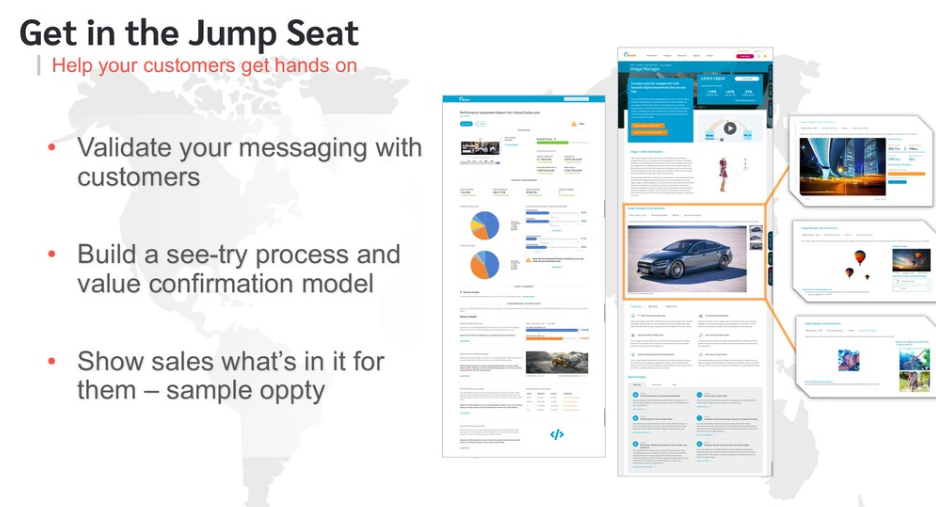
On the left hand side is an image weight impact report. So when we launched Image Manager, we wanted to somehow surface a bit of an attention getter for the sales teams to be able to leverage. What this is, is a customer can go in and plug in their URL and it will do an analysis of their website and tell them how they can improve their images, you know, are they optimised or not on both desktop and mobile, and what the opportunity is to make that a better experience. This is the number one lead driver on akamai.com and a great talking point for the salesperson to come in and say "Hey, you downloaded this and ran this customised report. Let's have a follow up meeting on it." It's a great way to help kick-start the conversation in the right way, on the right topic and on the right value proposition, and gives the sales team a head start.
The other is taking some of the product capabilities and putting them directly into the website. So actually a gentleman I used to work with, Parag, helped do this on the Image Manager website:
The key thing here is that getting those capabilities directly on the website makes the product tangible, and when we launched these it drove the webpage results to be much better, we increased time on page by about a minute and reduced the bounce rate by 20% by having some interactive elements of the product right there on the page itself. So that can be a very powerful sales tool, getting tools that you want the customers to see and making them public and then when the customer sees them, it kind of forces the salesperson to have that conversation when the customers enquire.
Join highly-distinguished sales enablement expert Sapphire Reels, and discover how to:
👊 Convey the importance of sales enablement and sell it to key stakeholders.
🔥 Design a sales enablement program from scratch in line with business objectives and sales needs.
🚀 Launch and iterate on sales enablement programs.
🤑 Communicate the impact of sales enablement on the business and revenue generation.
Refine your strategies
Strategy #2: consistency, consistency, consistency
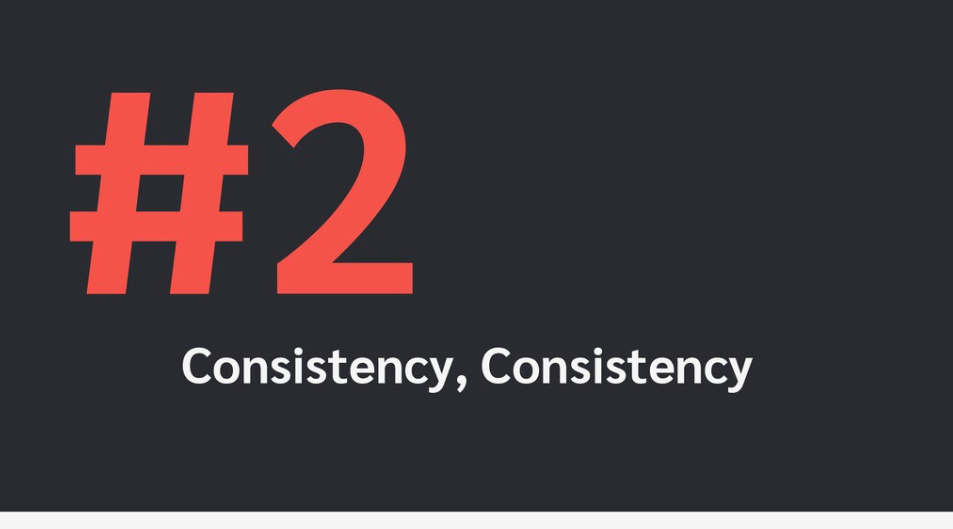
Now we all want to iterate, make our messaging better and better and better as we learn more, and that's important to do, but too much iteration can actually work against you if you're not iterating at the core of the message and you're only iterating out at the perimeter.
What do I mean by that?
So, having foundational positioning and messaging ia Pragmatic best practice, of course, but I find too often that teams will do this exercise once. They'll build their positioning, they'll build out a messaging document, and then they won't touch it for a year, maybe two. But they'll have all this web copy and email copy being built off it with extended marketing teams, they'll revise maybe the pitch deck three or four times, but they won't necessarily go back and update the core. If everything's not being driven from this core positioning and messaging, then you end up with that fragmentation of message, and so the salespeople are latching on to the one that they can either deliver best or sounds the best to them and customers - globally - are hearing something different depending on what they're looking at on your website or email, and so forth. So making sure you're using these not just as a worksheet to document your thought process to come up with the messaging, but using it as a source document for extended marketing functions - whether that's your corporate marketing team that's doing the website or your lead-gen teams that are building email copy - and that they know this is the deliverable for them that they use downstream.
If there's a core document they can work off, it alleviates the pressure on you to have to give them a jumpstart on everything they write. I don't know if everybody is challenged by that, but I get marketing teams pinging me "Can you help write this email?", "Can you help write this webpage?", "Can you do this?". We can't be copywriters for dozens of field marketers around the world, and so having this foundational document really helps drive that consistency but also alleviate you from having to be a copywriter in your spare time.
Sales tool kits
This is a no brainer, right? Everybody has a sales tool kit where their their materials are posted, but there are some ways that this can be really successful and there are also ways that this can work against you. Sometimes I see that people will just post everything and just keep adding and adding and adding and adding until there's this embarrassment of riches of sales tools. Unfortunately, when that happens, the sales teams don't really know what to use and when and it becomes very, very challenging. So that's when you then get the email like "Hey, can you send me that deck?" Or "Hey, can you send me that brief?" Because they don't know where to go or how to find it, so constantly pruning and purging out the tools that are out there and only keeping what's really critical is important in making sure it's organised by use case and asset type, and then by sales stage is important for your newer reps.
We actually went through an exercise of revamping our sales tool kits where we had the hyperlink list like this:
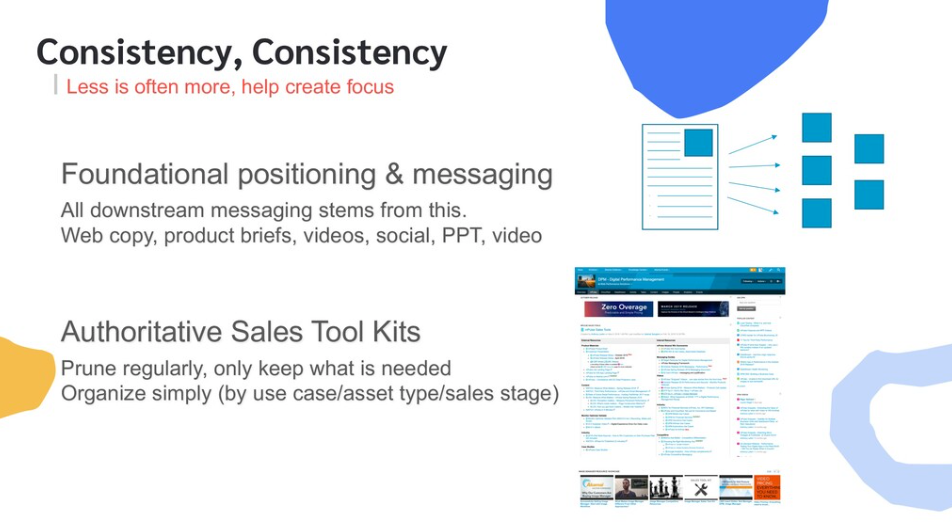
And then we built them all the way out into the six sales stages and we had sales tools by sales stage, and you had to go into the sales stage guidance in order to get each of the tools. We got a lot of great feedback, very vocal and passionate feedback from some, about that reorganisation. We found that for the more seasoned reps, they like this model. They just want to know where to go to get the things they need, and they just wanted to be able to look by use case or internal/external and grab the links to use. However, for the newer reps, they really need it organised by sales stage because they don't know what assets to use during discovery, they don't know what assets to use during prove, they don't know what assets to use during value confirmation, and so having that mapped out for the new reps, we got feedback that that was really, really beneficial, but for the more seasoned reps they like this model. So we have both, and we have to keep both up to date, but it means we're actually able to serve a broader need across the organisation by catering to those two models, and we saw a lot of success.
Now, we weren't lucky enough to have some fancy sales enablement software that allows you to track all kinds of metrics about who's using what and organise it in a fancy and engaging layout, but this really worked for us to be honest, and it worked at scale. So if you don't have one of those, like a Seismic or Highspot or something like that, if you have an internal intranet site just having a hyperlink list does the job.
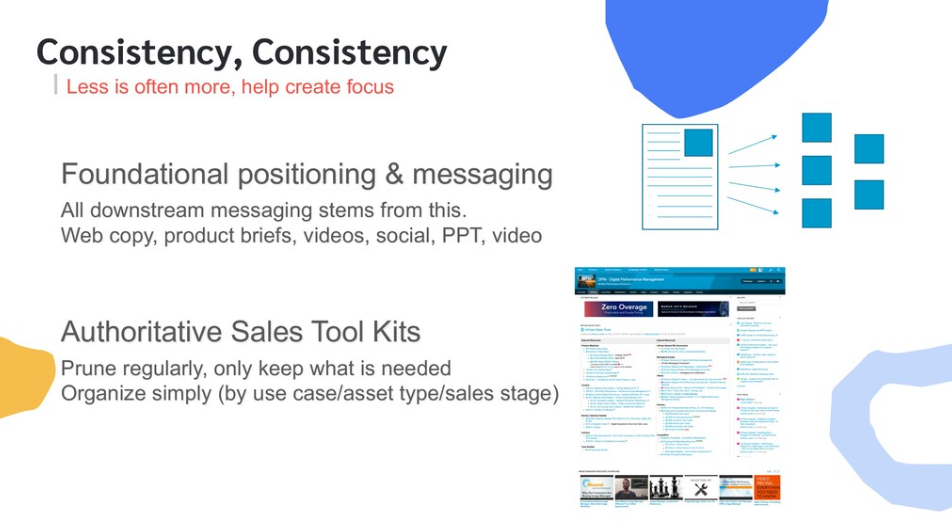
So, we talked a bit about the foundational positioning and messaging, solutioning is really important too. When you have a broad portfolio of products, the sales teams can't always put it together, so it's really important to show them and have tools that will show customers how these things work together in order to drive consistency. To do this, we built out solutions, use cases of reference architectures, which enable conversations around "These are the different pieces that you need to drive, let's say, API security or drive peak consumption of your web application" and so forth, and it helps them tie it together.
Then, having sales plays that document and train on how to sell those solutions with specific guidance along the way and aligning the solutions to a broad go-to-market strategy with unified messaging. This actually led to a twice a year product launch model, so rather than doing launches for every product release we had, we grouped them together and twice a year we had a platform release that brought the messaging together.
From both customers and analysts, we got incredible feedback that, that simplified the message for them and they really started to understand what direction we were driving innovation. And then the sales teams, they found it more actionable because they weren't having to play whack-a-mole with new product launches and new new opportunities, because their account planning is on a 6-2 month cycle, and so they really need some firmer and more predictable cadence for when we're making these product releases available to them - as well as obviously all the tools needed to bring that message to market as part of it.
So bringing it together with consistency and really hand holding them and showing them 'this is how you use these materials' is extremely important. That's the gap I want to re-emphasize. A lot of times we put these things out there, we say "Here's the deck, here's the analyst report, here's the whitepaper" and assume salespeople should just know how to use it. Oftentimes, they don't. They don't even know how they should introduce this thing to a customer. Should I send it in an email? Should I bring it up in a meeting? So that level of how we expect them to use it is really important. It seems a little bit like hand holding, but if left up to guessing, oftentimes, that's why you'll see your materials left on the shelf; because they just don't know how to use it. They're probably willing to in a lot of cases, they just don't know how.
Strategy #3: video killed the PPT star
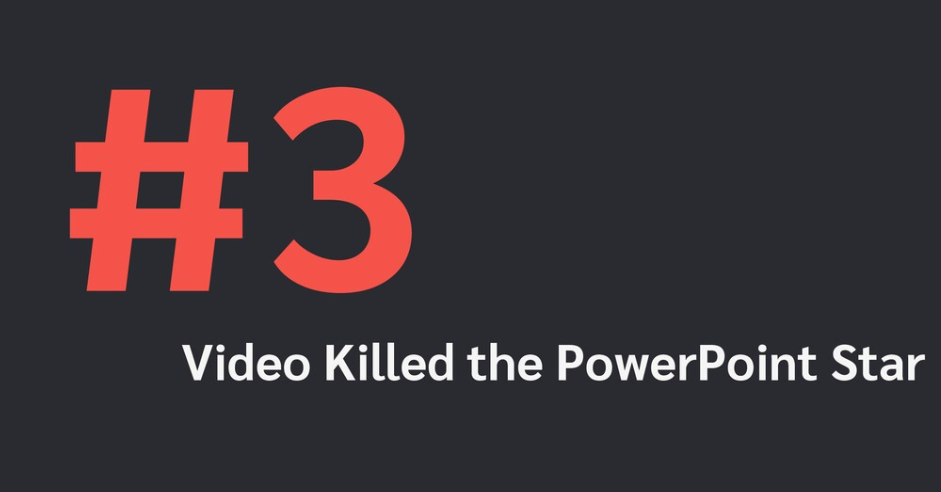
Internal webinars are fun, right? No, they're not. They're dry, and we found that people will attend them if they're required to, but they'll also do other things, like email. We started to do a lot more on-demand video training and making stuff available and then sending out notifications and triggers so they can watch it on their own time, and this worked really well. We got incredible feedback from the sales and pre-sales teams.
The best part? It was free. We didn't have to hire a contractor to do this. Everybody has a webcam or a cell phone that takes video. It's just DIY videos - I used Zoom or Google Hangouts, and have a conversation with a Product Manager or an SC or a salesperson that had a recent win. Have that chat, record the screen, do quick edits on the end, you can do some image layovers in iMovie which is really easy with screenshots, and then boom, you have a library of more engaging video training that takes only a few more minutes than creating a PowerPoint presentation and to be honest, sometimes less time, because you don't actually have to create slides. Some of the feedback that we got was:
- Much more engaging than slides and voice overs
- Really useful
- Waiting for more videos
- Love the approach
- Great work.
People really loved it. And don't be afraid to have some fun with it. Look at our Pikachu here:
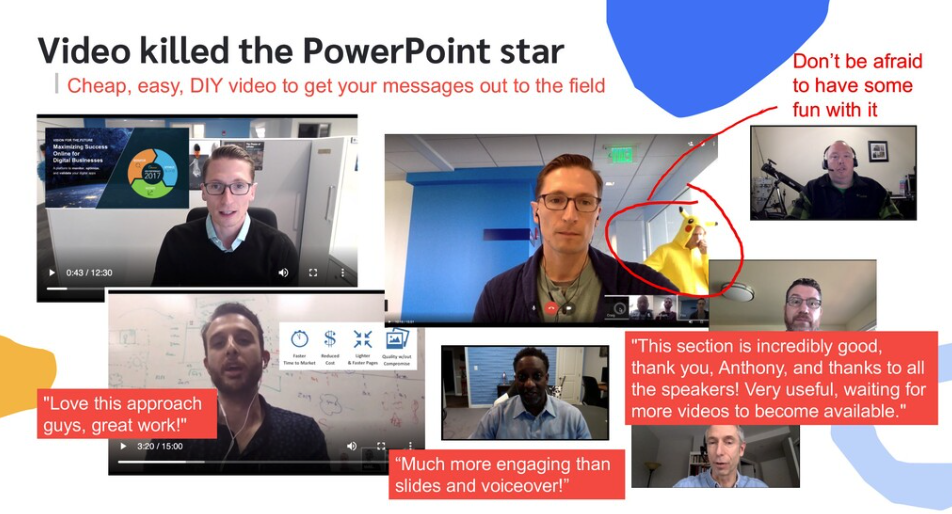
That's out general manager, SVP of the Performance and Security Division at Akamai, I convinced him to put on a Pikachu suit and walk around and pretend to be on a phone call in the back of the video, and we ran a little contest. If people could guess who that was in the costume, we sent them like some Alamai swag and people got into it. It was really great. So anything you can do to just get people's attention and keep them engaged can really go a long way. People would ask for more video updates after we started doing this, so it really was a success.
Remember, it doesn't have to be intimidating. You don't have to be a pro at video, it doesn't have to be fancy because its internal - you're not putting these out to the public, and so like I said, Zoom, Hangouts, FaceTime, you can do some screen recording, QuickTime, there's ways to do it using that. There are plenty of free tools you can download to just do quick video editing.
Tip: these files will be massive - it's like a 90MB video file, a tool like HandBrake will help you compress it down to something you can upload to your intranet site or share around that won't break the site.
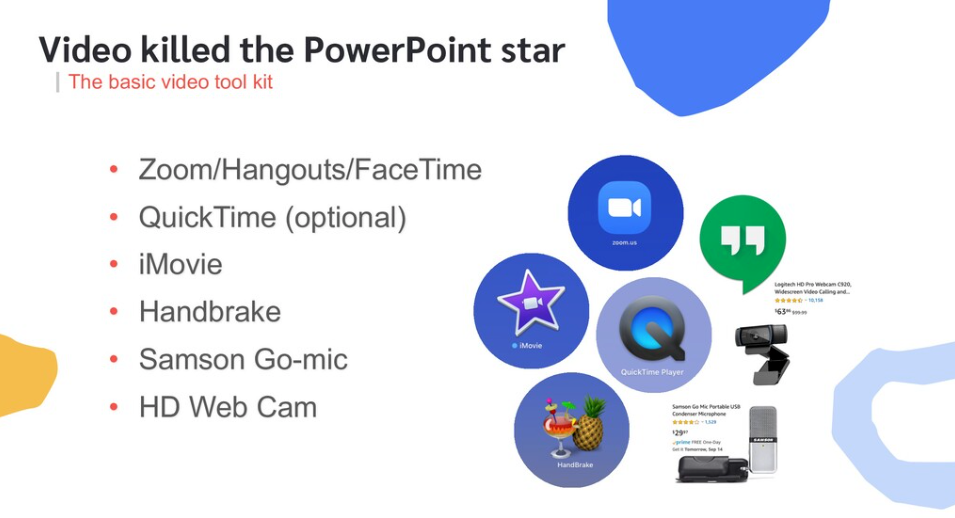
With this one, it's really just getting started. It may sound intimidating, you're gonna sit there with a notebook and delay, but just hit the record button, start talking, you can delete it, you can try it 10 times, but just get started. Before you know it, you're going to be inviting people on your mini talk show and getting the sales teams to listen to your training and messaging and it's an incredibly powerful tool, so don't be intimidated by it.
So, just to recap a little bit:
- Number one: nothing interesting happens the office. You're really going to learn a lot at the point of sale by going out with your sales teams and getting the feedback on the messaging, and doing that training live and in person.
- Number two: consistency, consistency. Make sure when you're developing foundational positioning, your iterations are at the core, not at the perimeter, and that you're constantly bringing the best of the tribal knowledge and bringing it back into the institutional knowledge and making that available through a consistent set of tools that's not overwhelming to your sales teams, so that everybody can stay on the same message and the same tools.
- Number three: don't be afraid. Just start creating some videos. If you need some messages to get out to the field and you feel like they're not listening, this is a great way to try and change the game on dry PowerPoints with voiceovers, or just sending out email blasts. On-demand video, if you're lucky enough to have an intranet site or an internal community or something like that, you can post the video files up (keep it to 5-7 minutes) and I think you'll get great results.


 Follow us on LinkedIn
Follow us on LinkedIn
